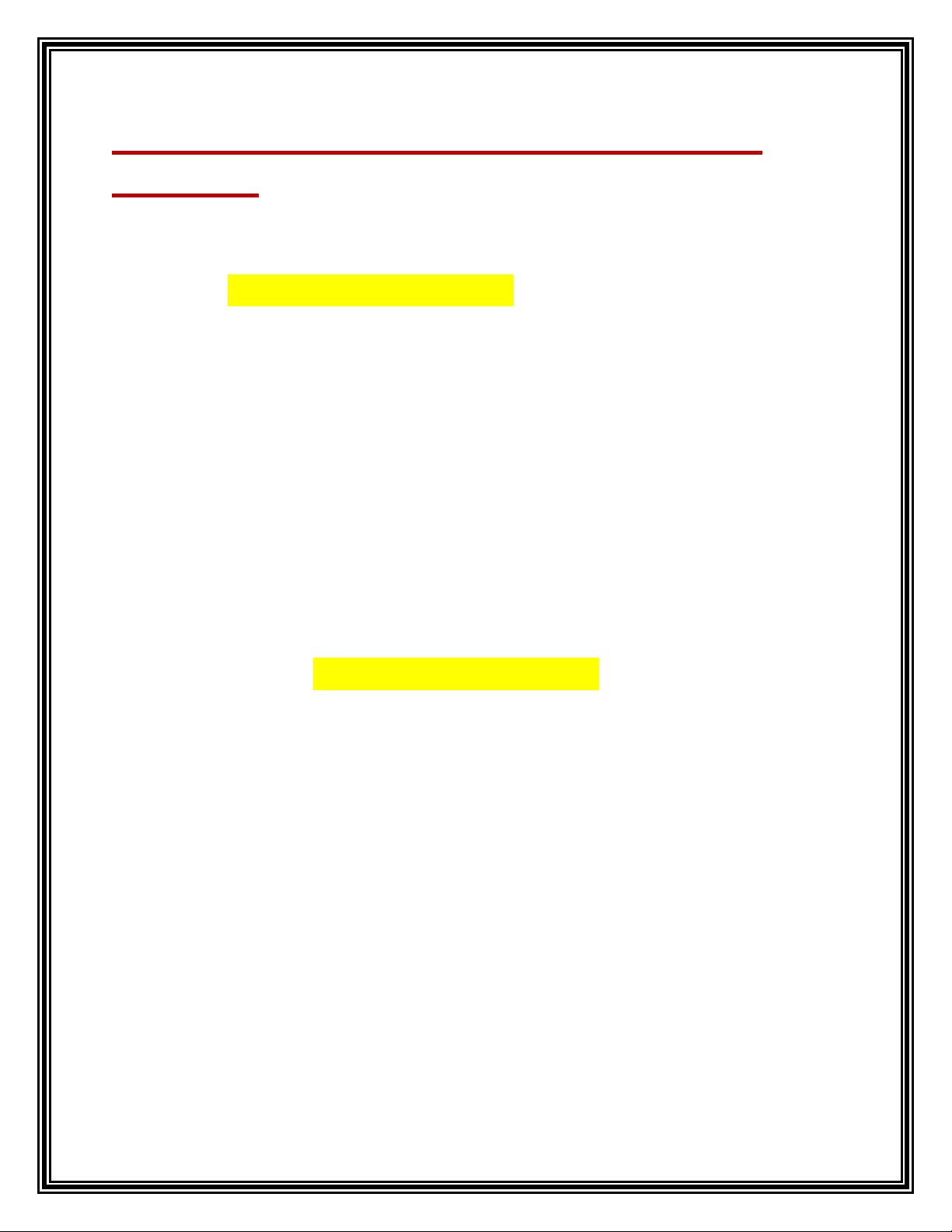
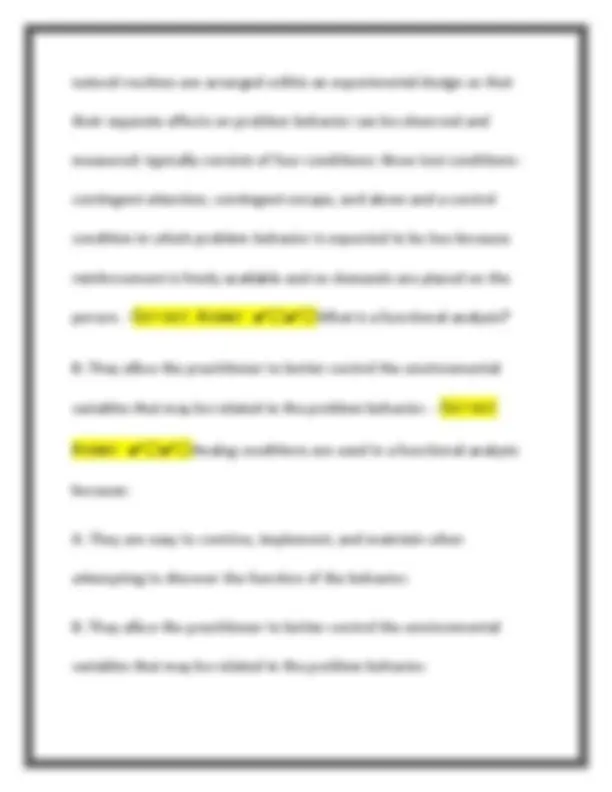
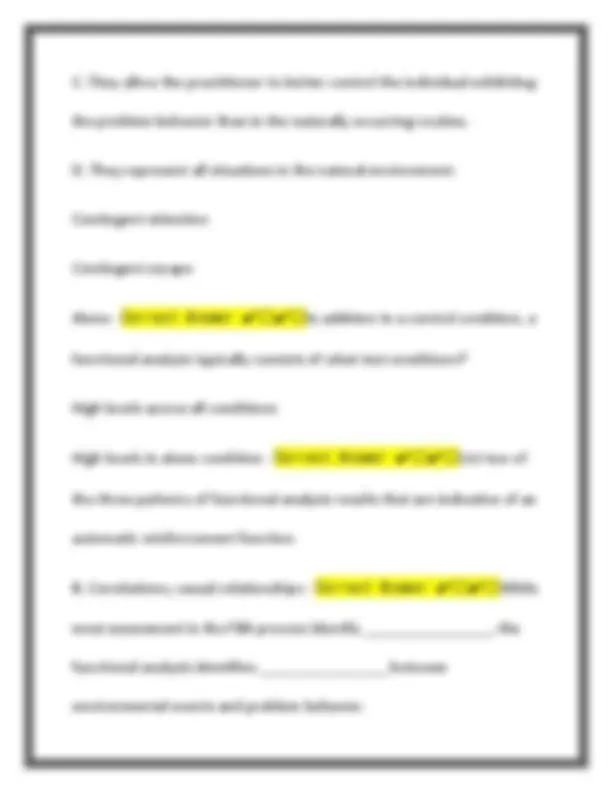
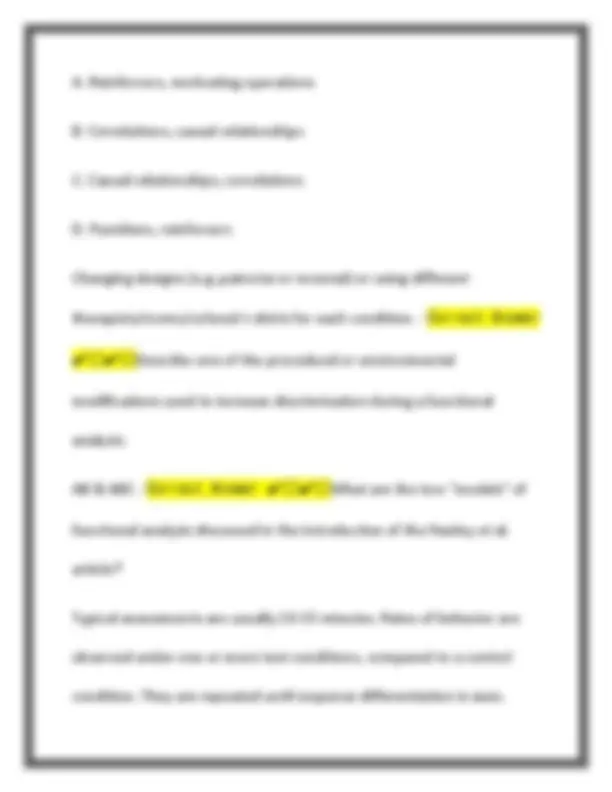
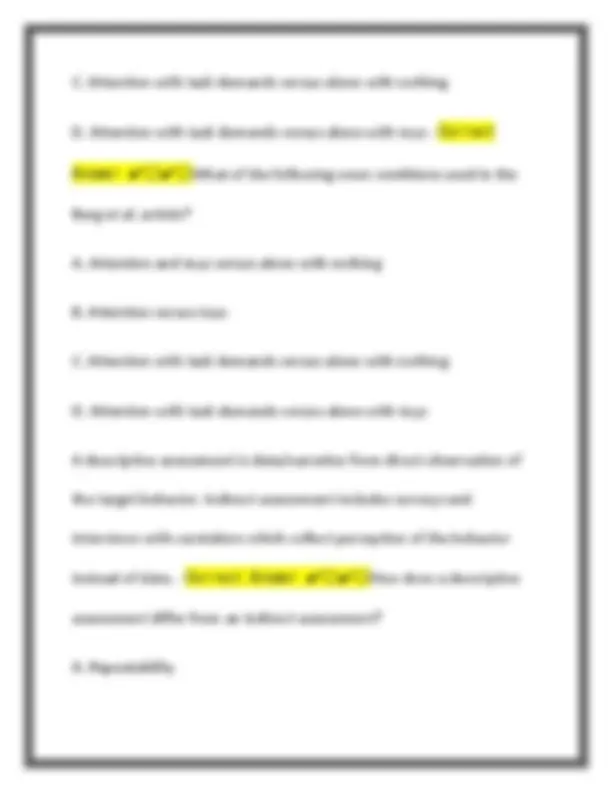
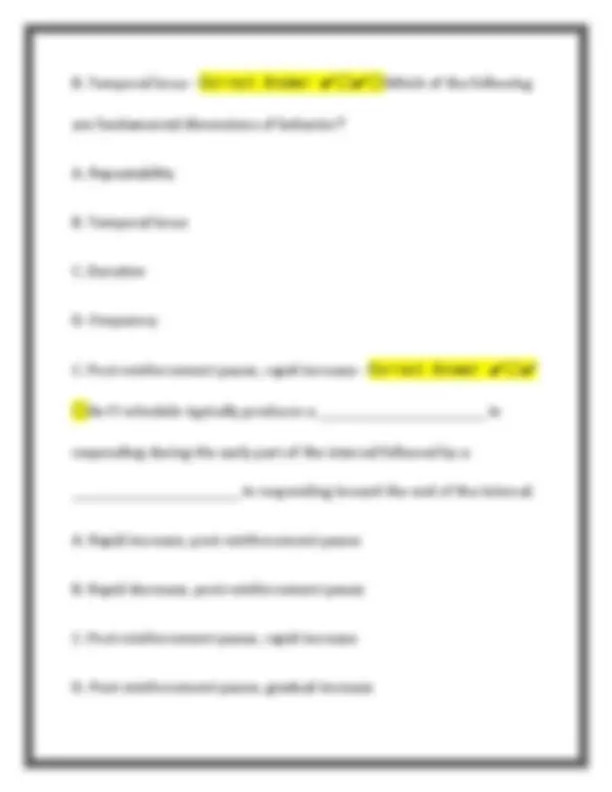
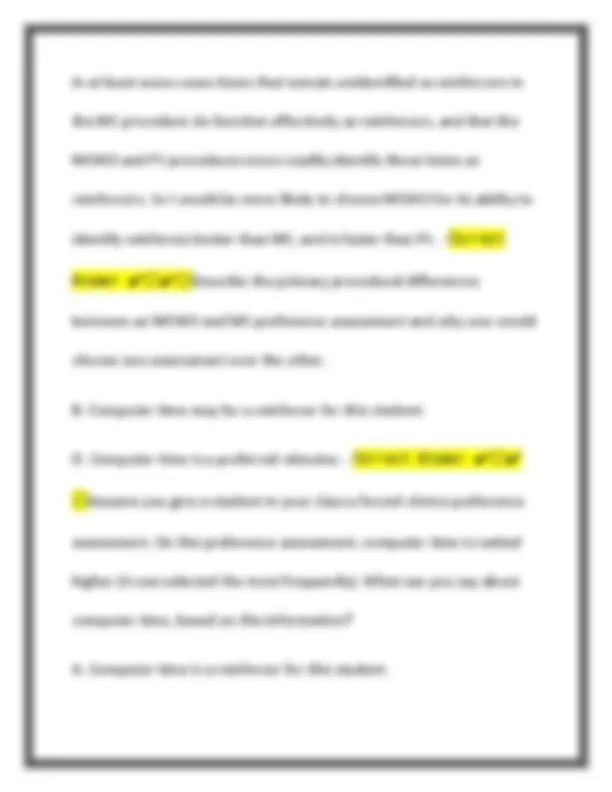
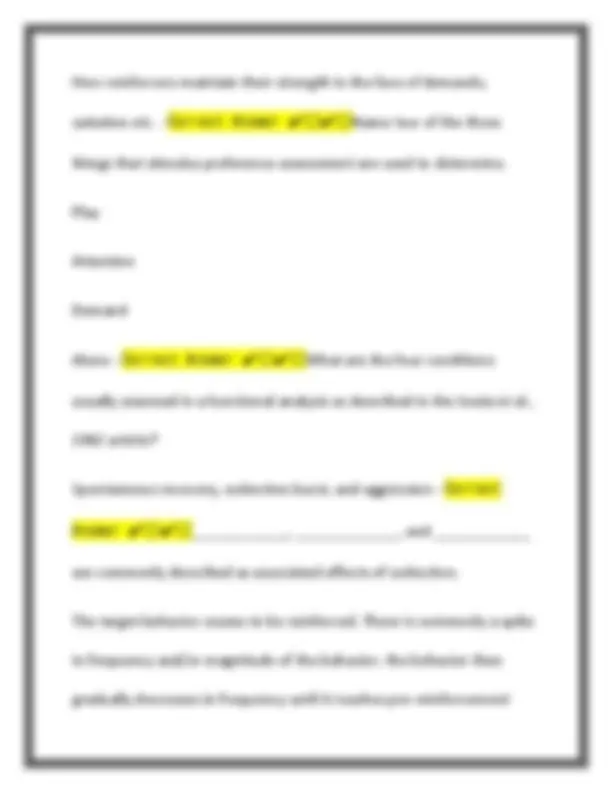
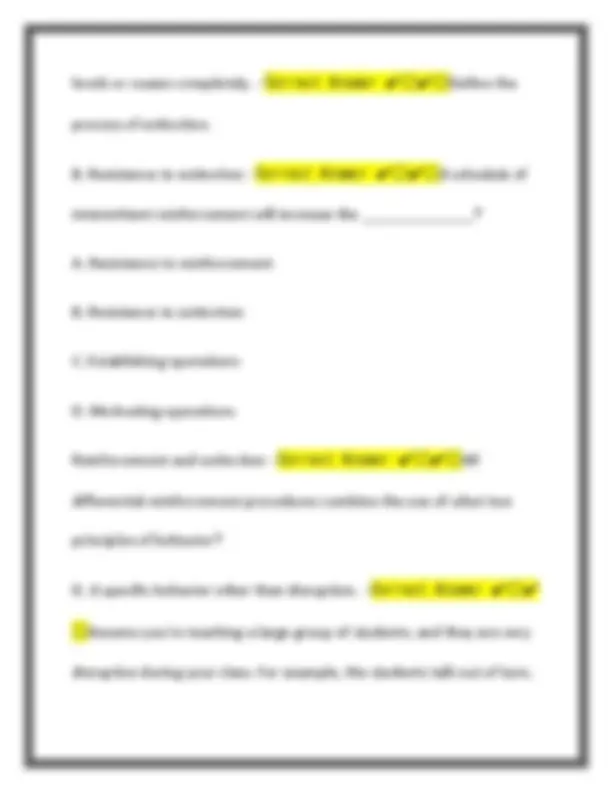
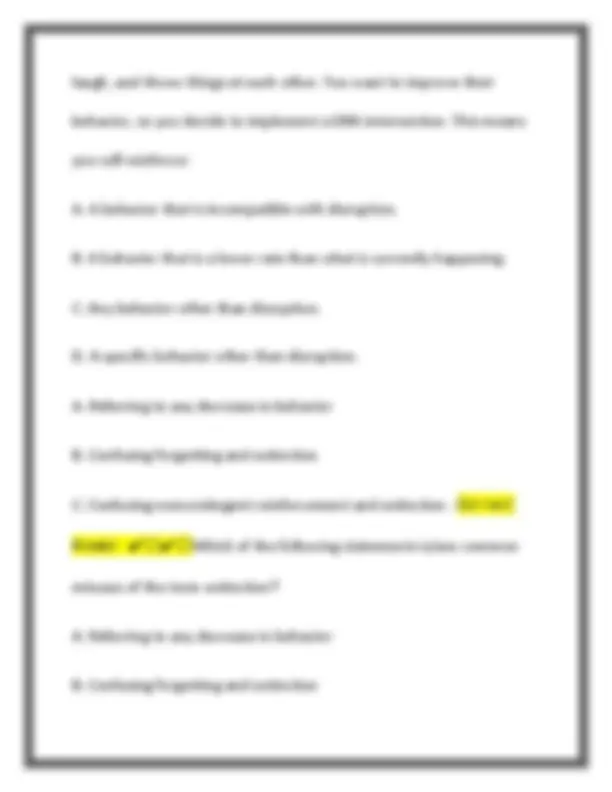
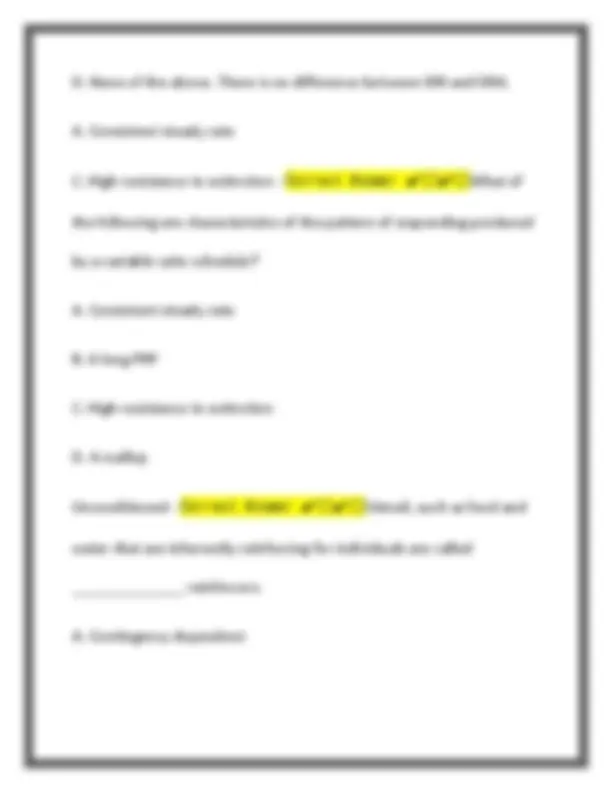
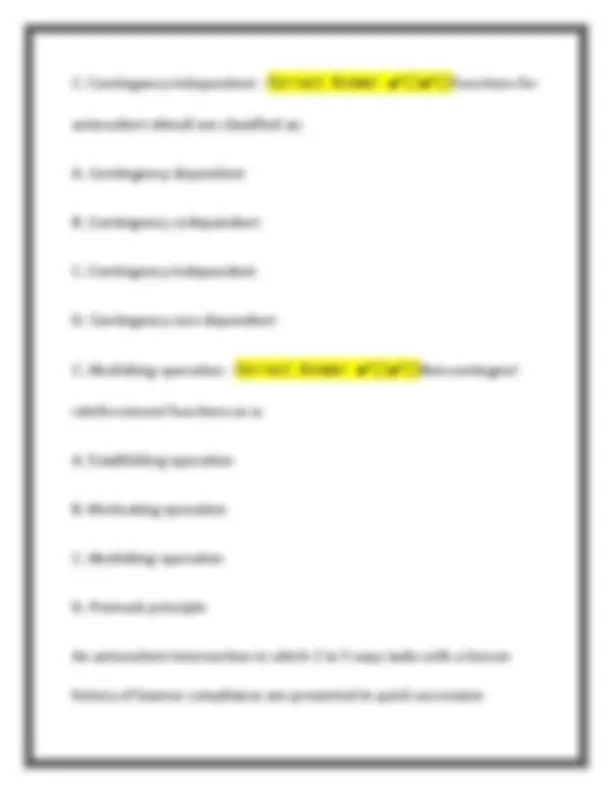
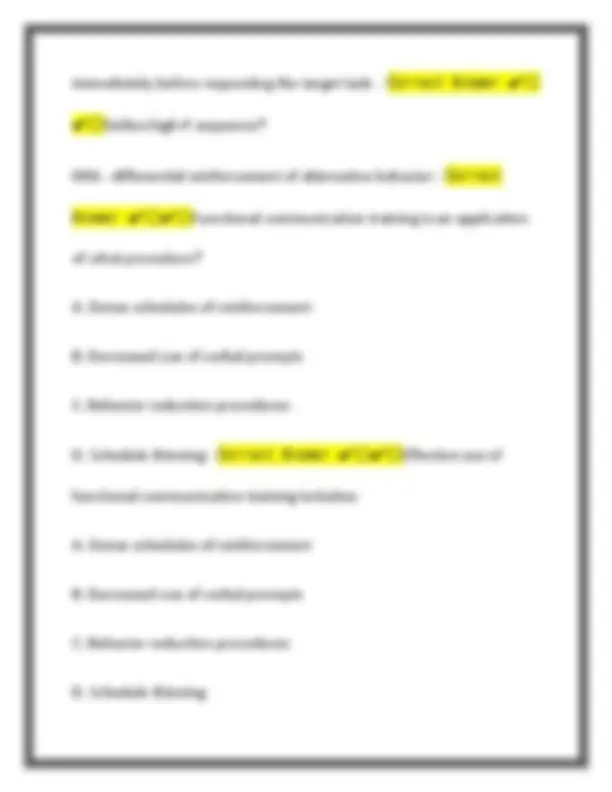
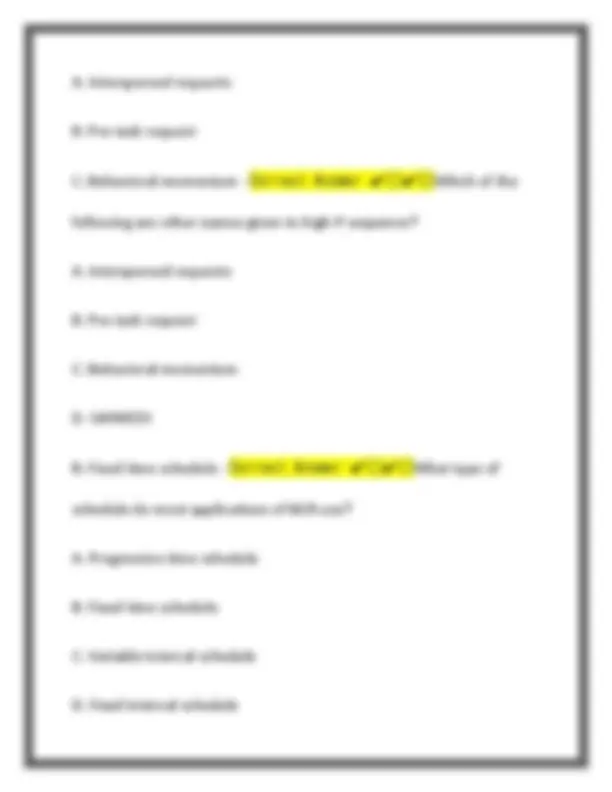
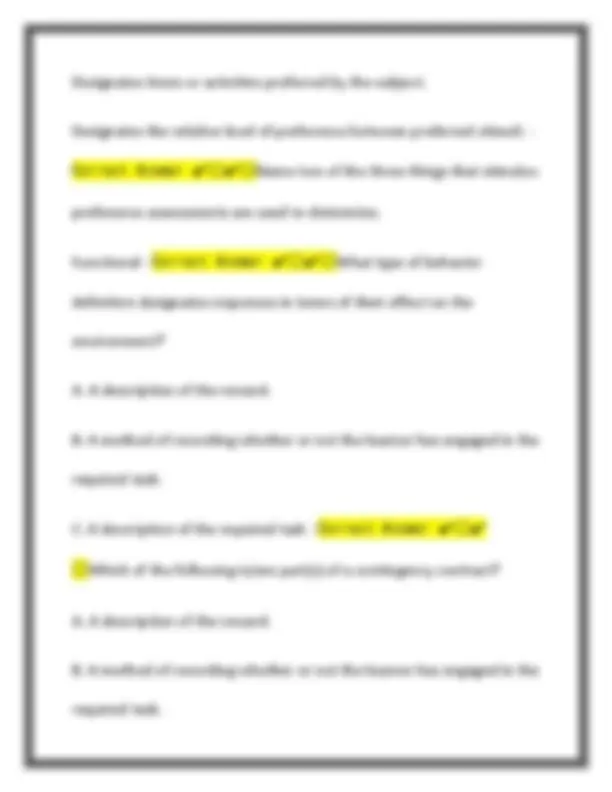
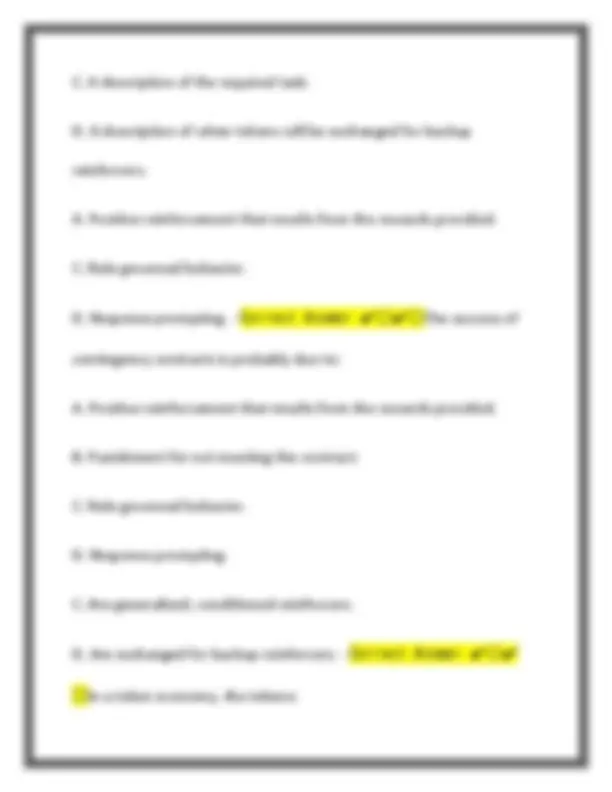
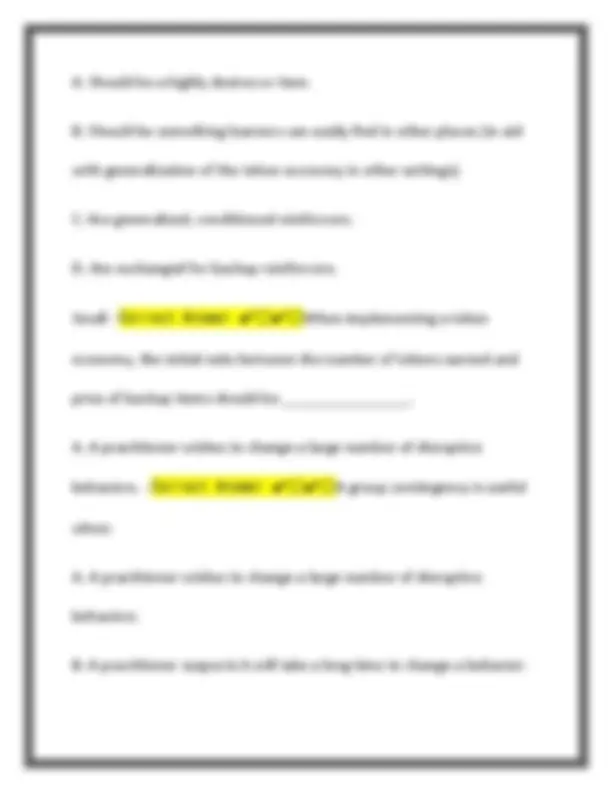
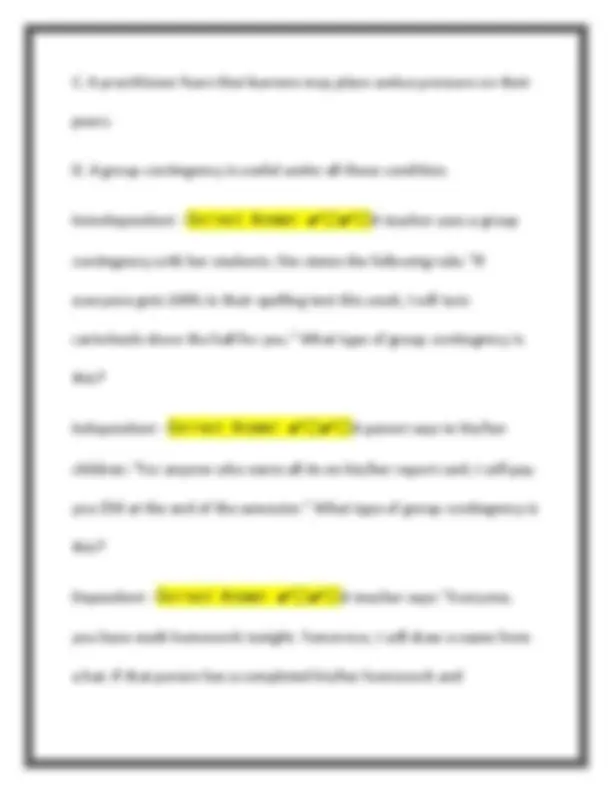
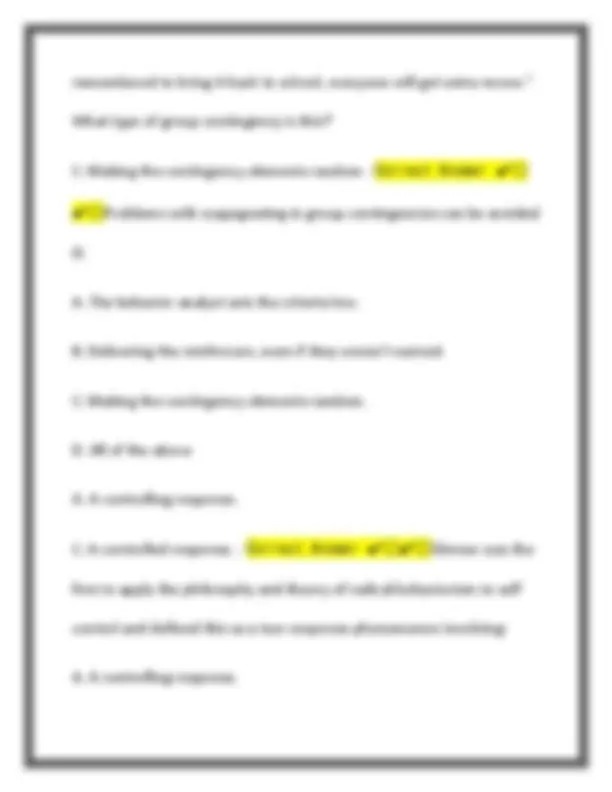
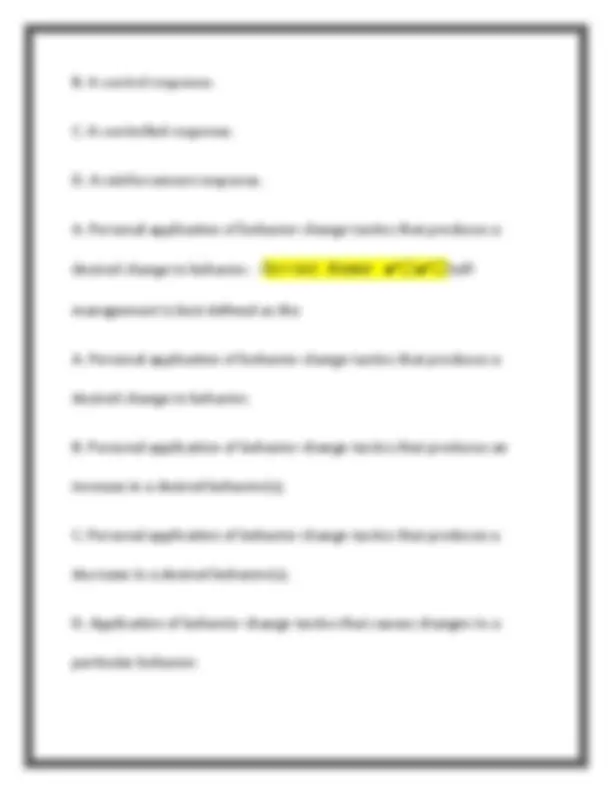
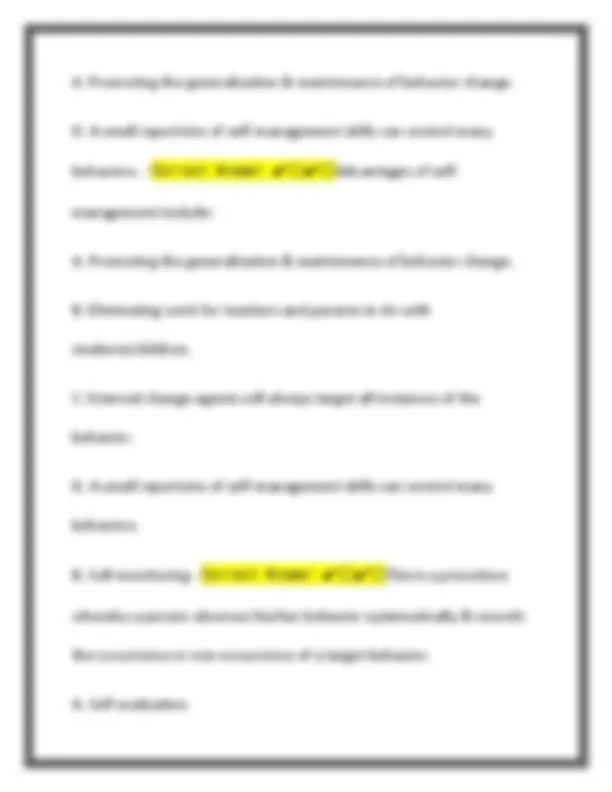
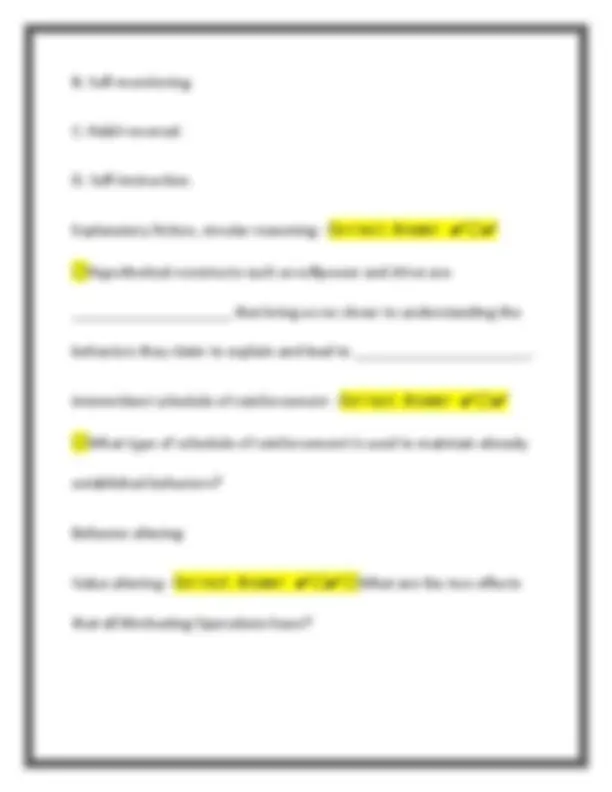
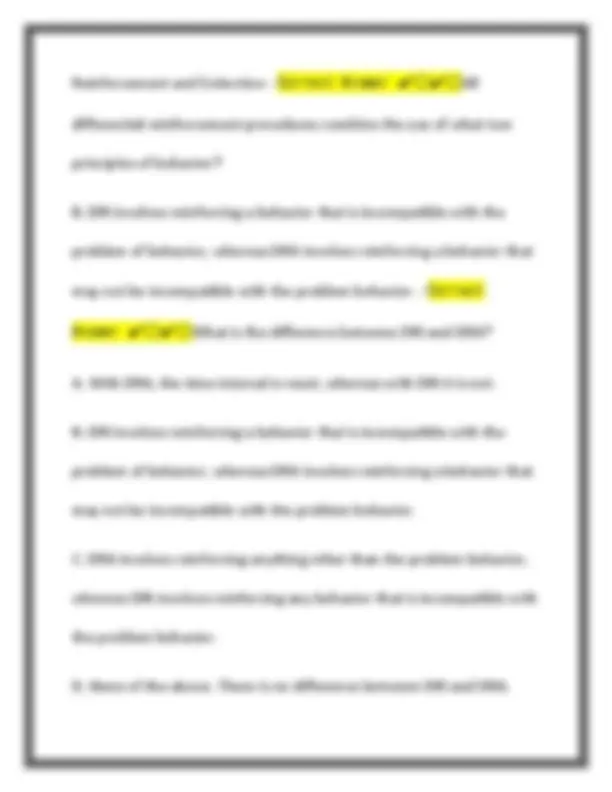
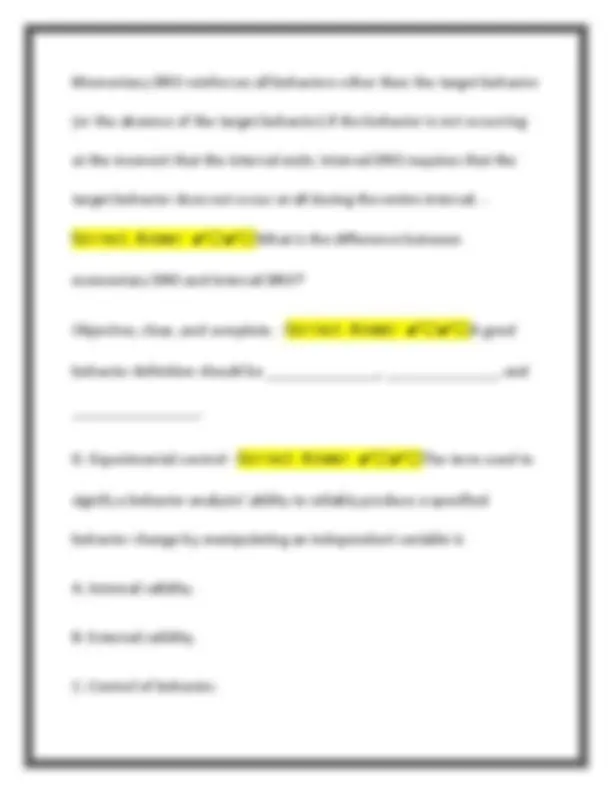
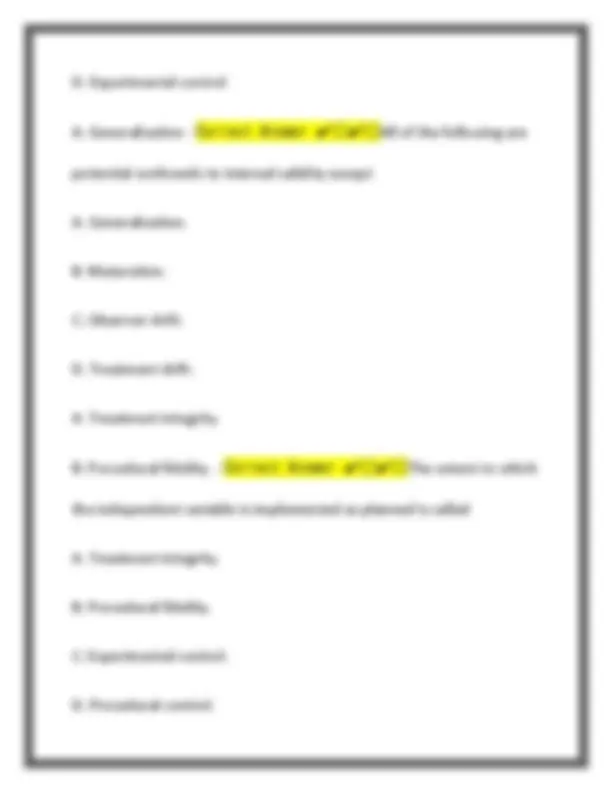

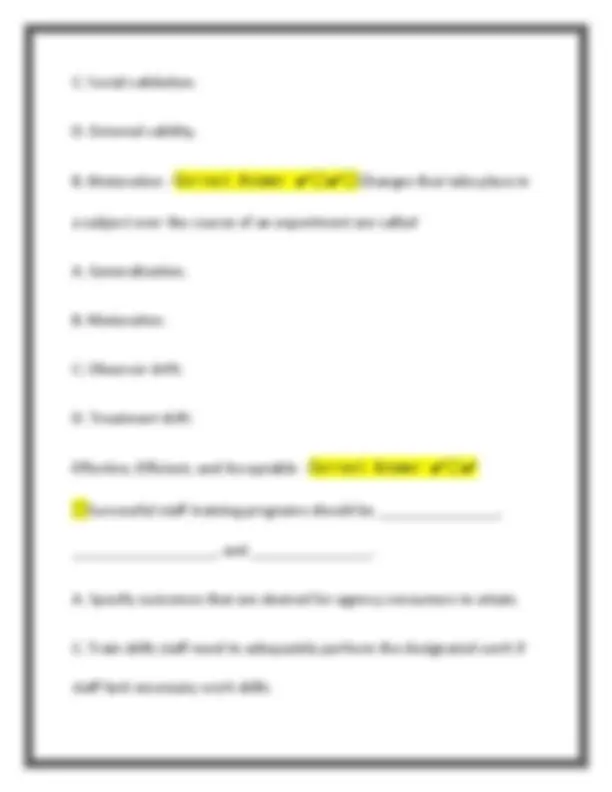
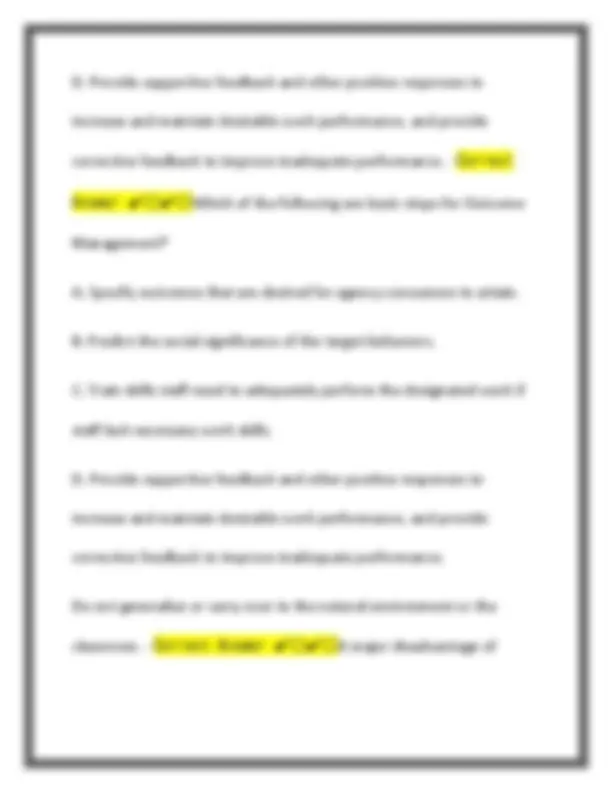
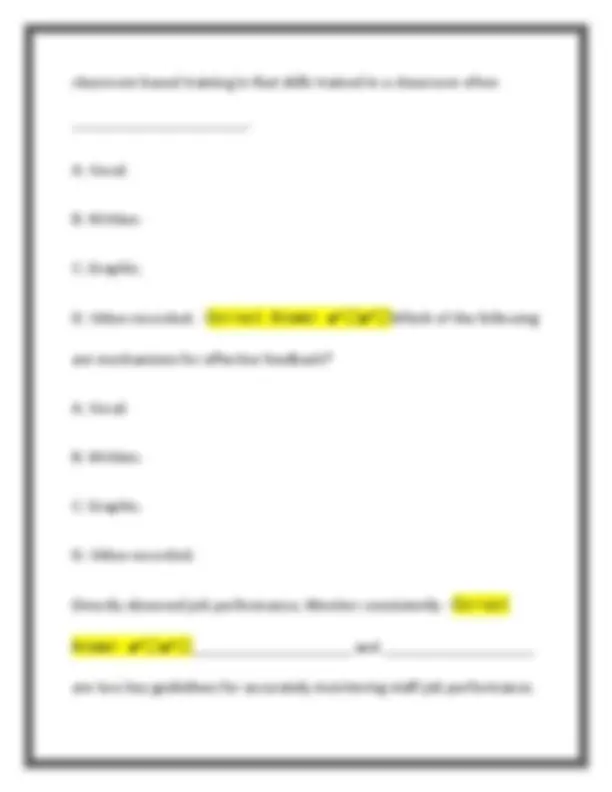
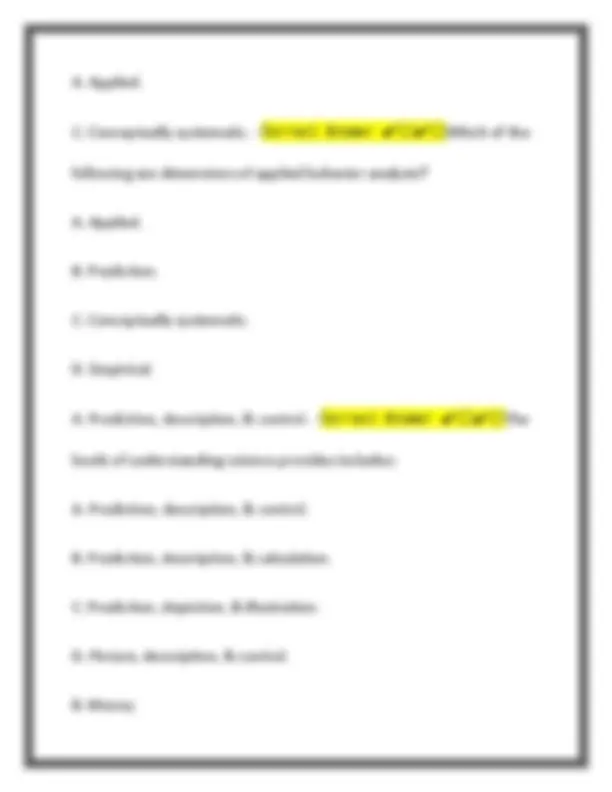

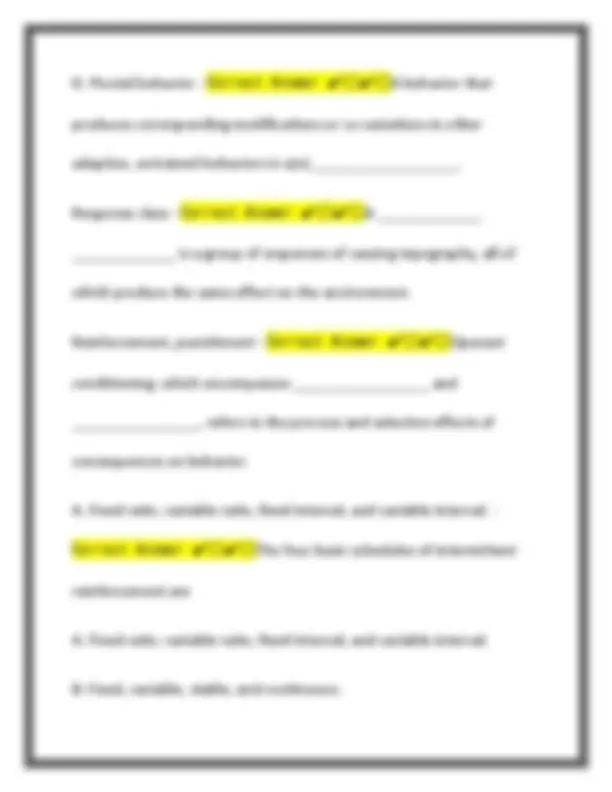
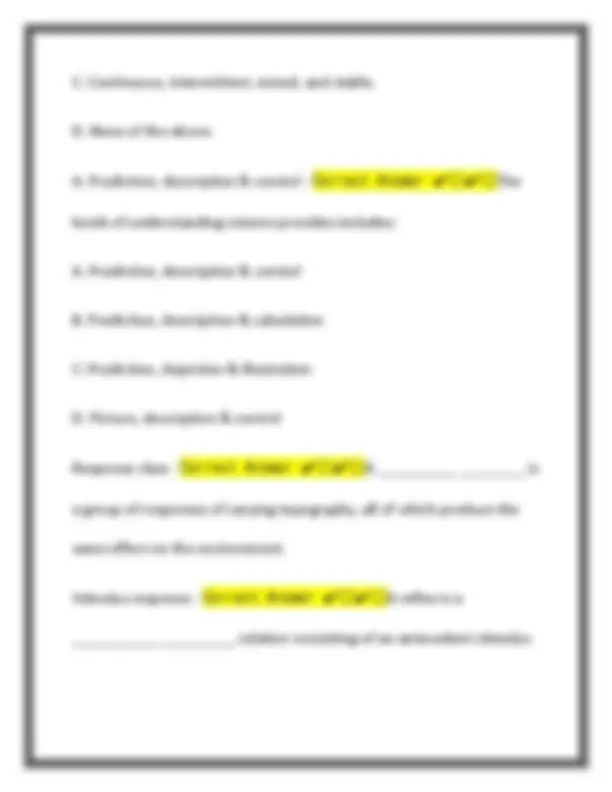
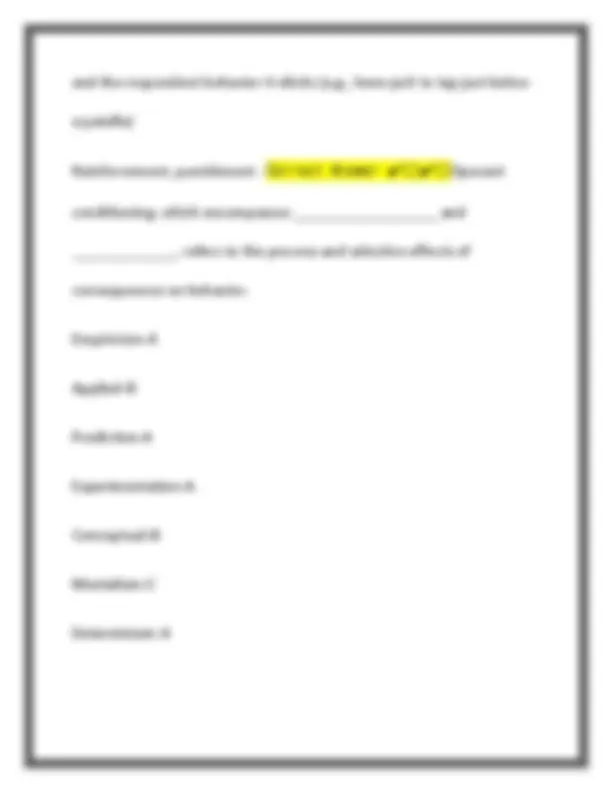
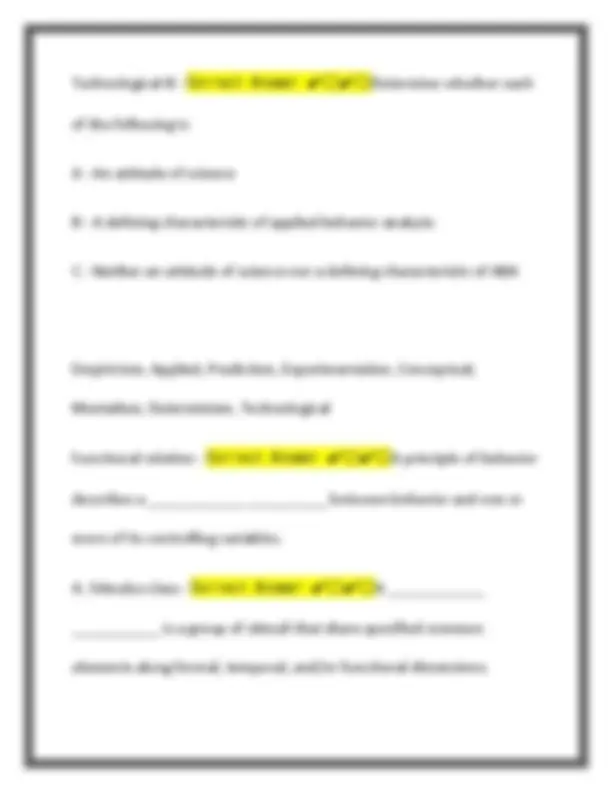
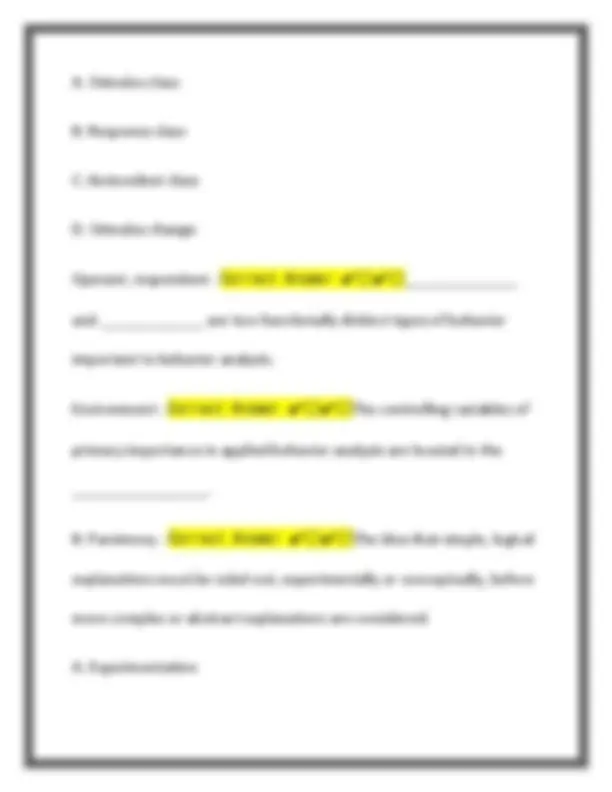
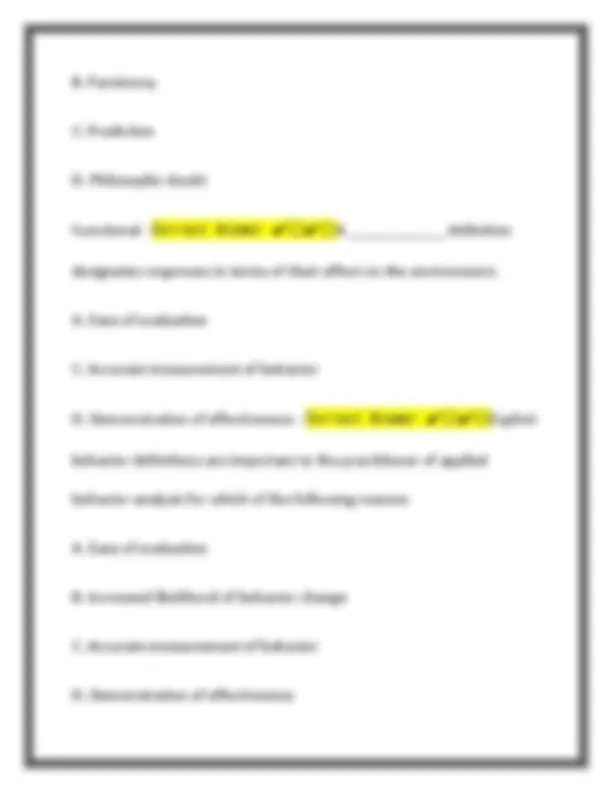
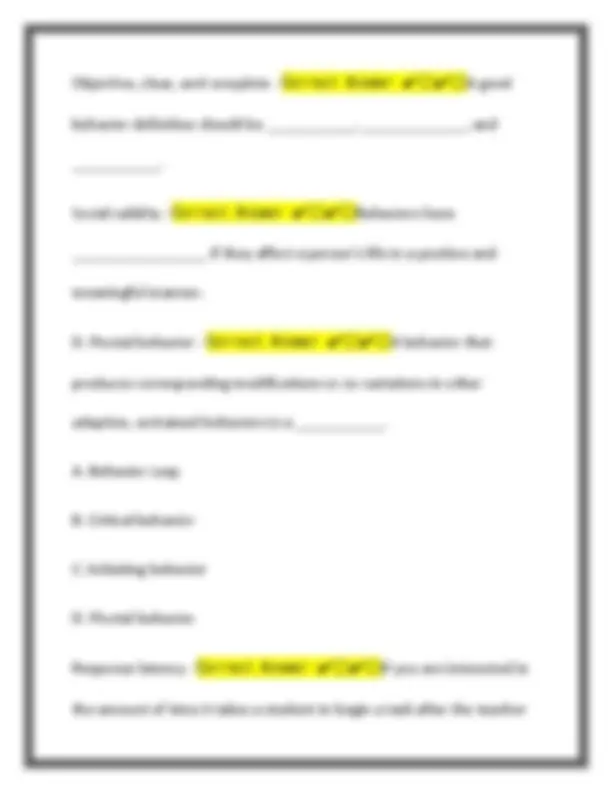
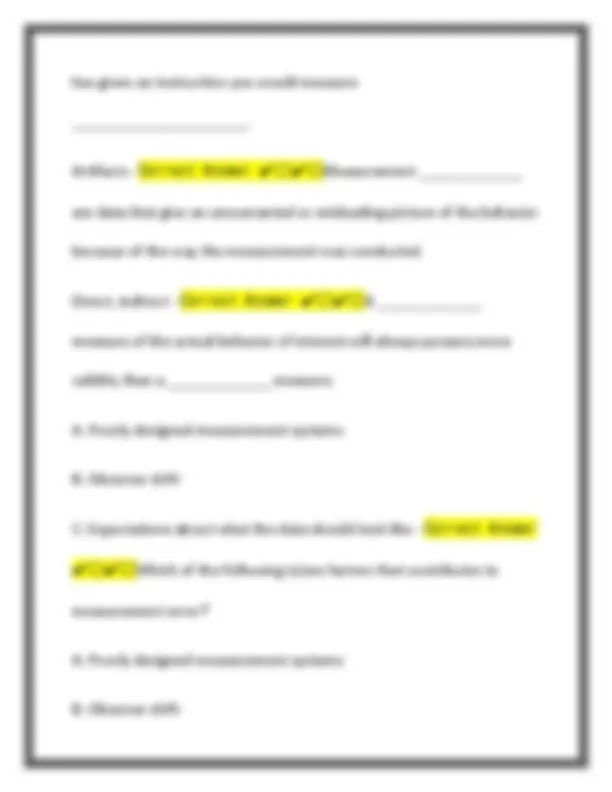
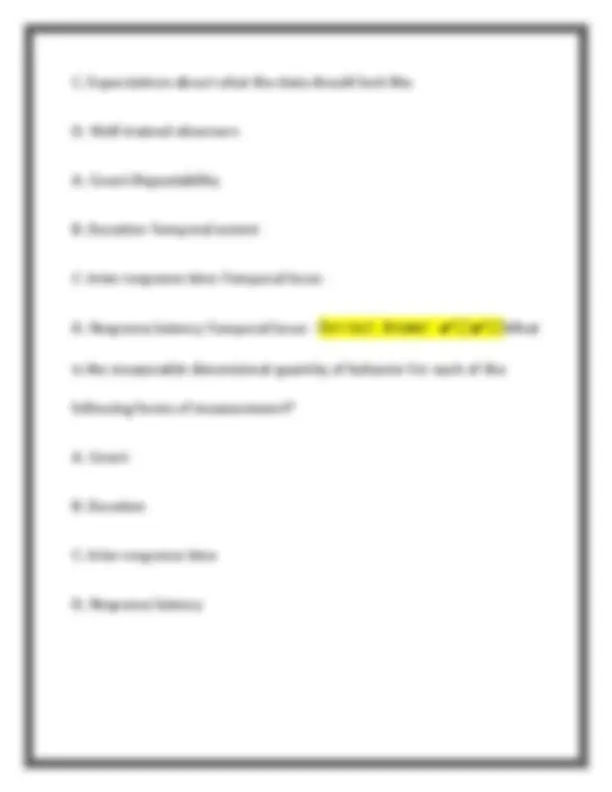
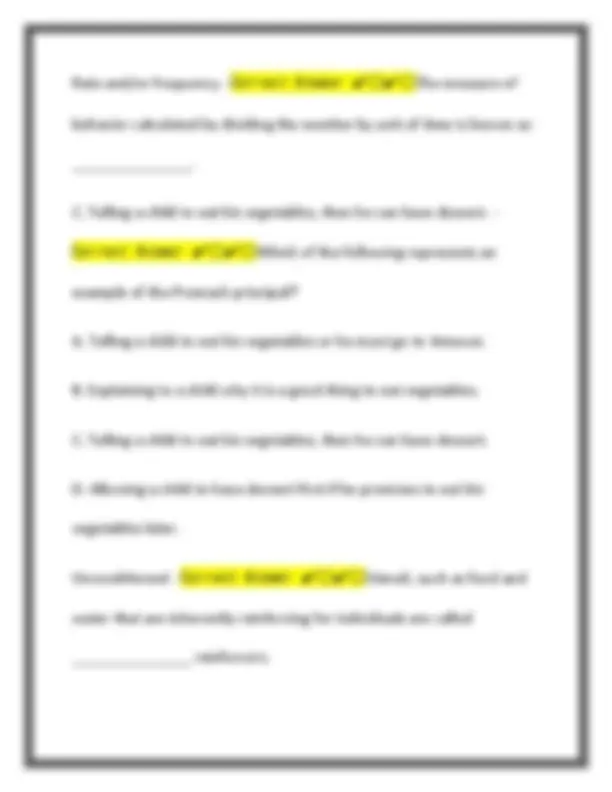
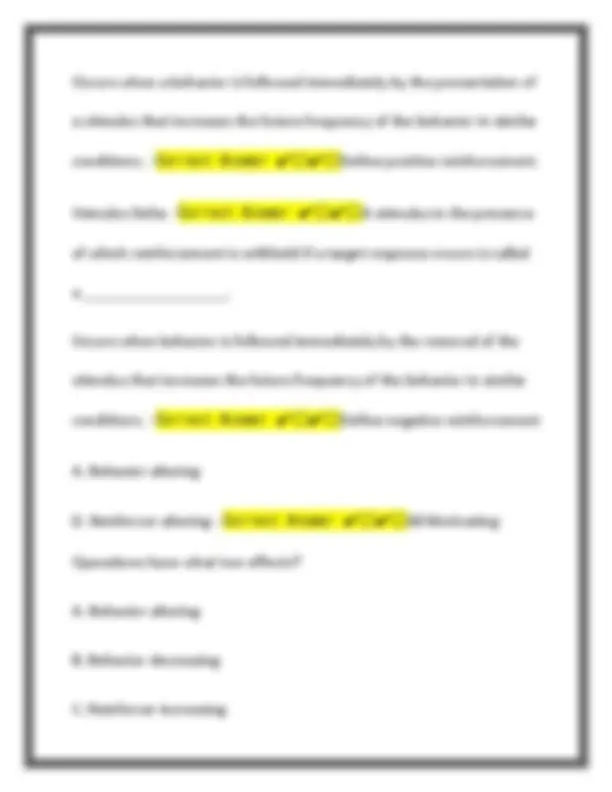
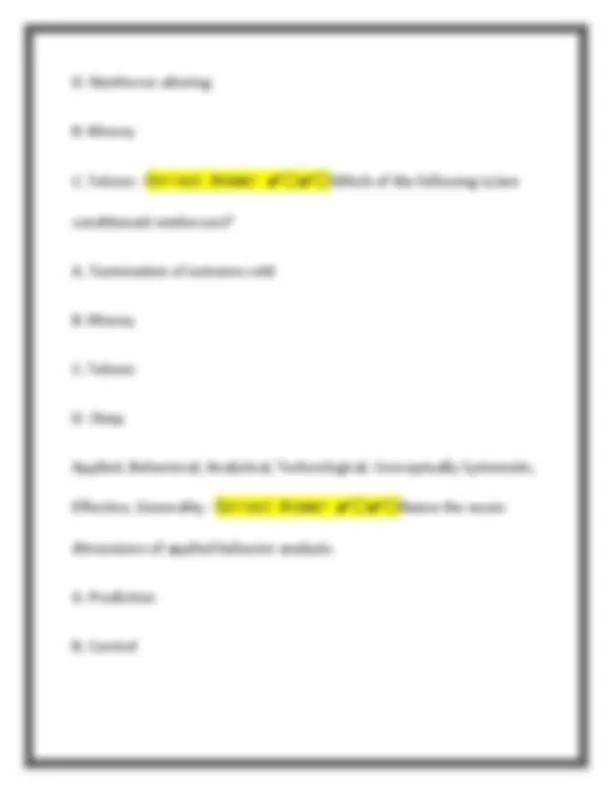
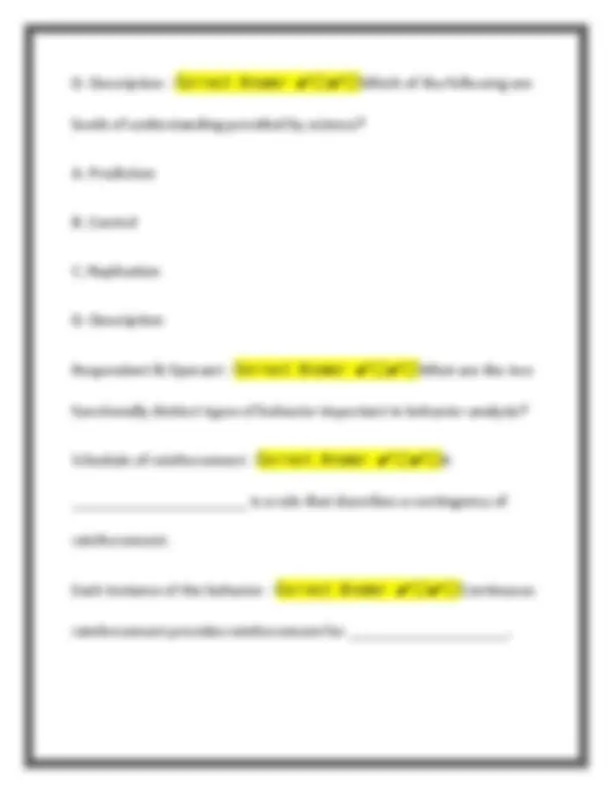
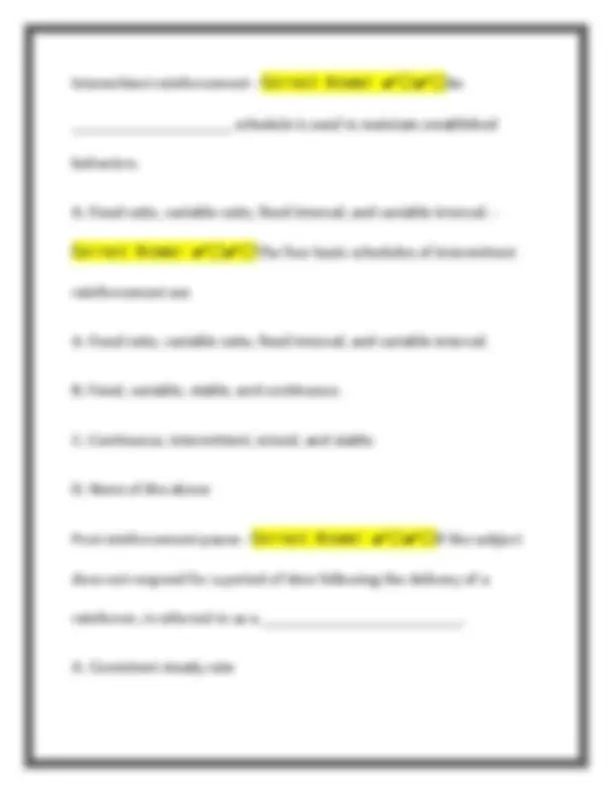
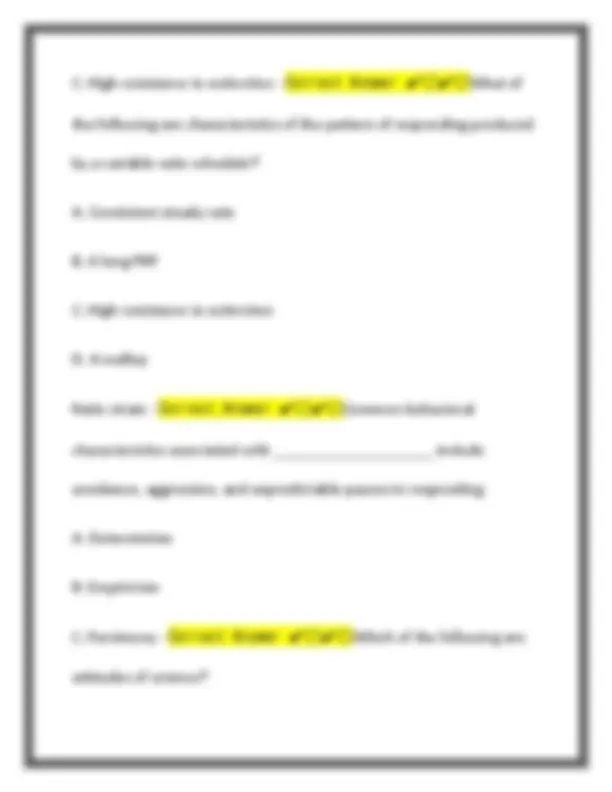
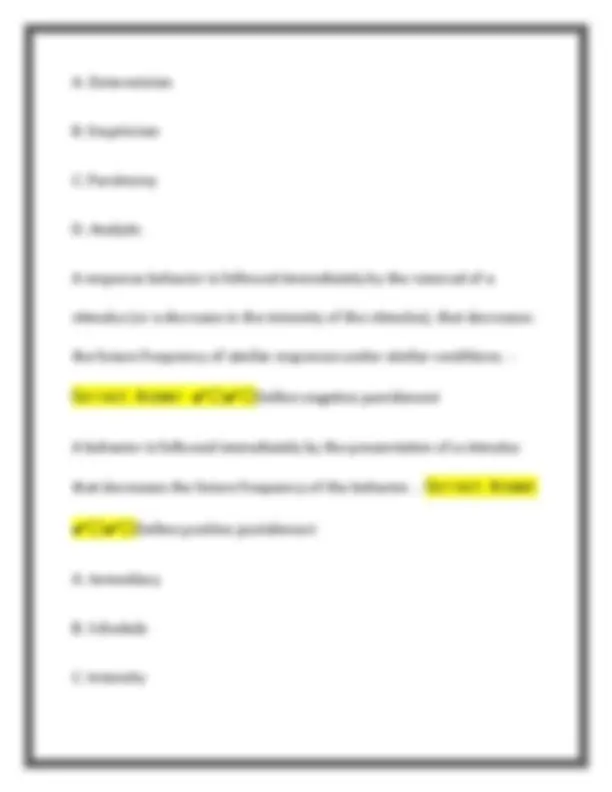
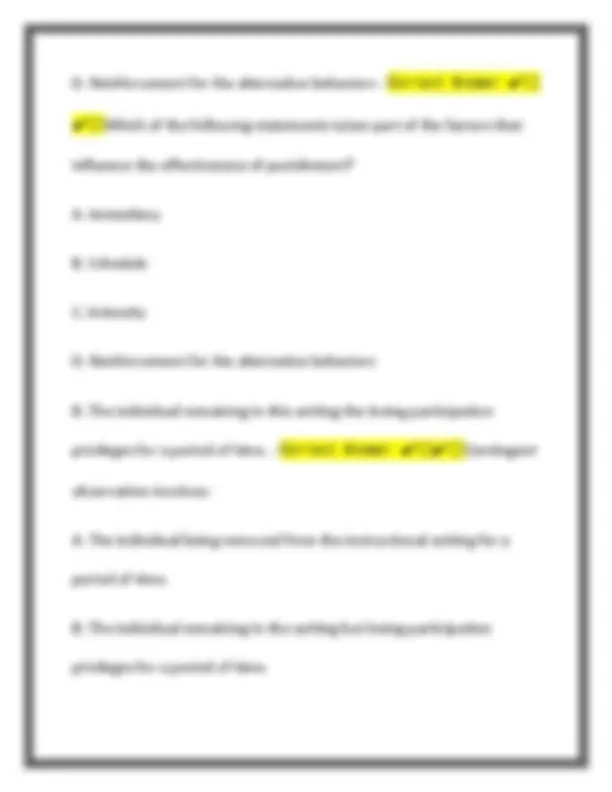
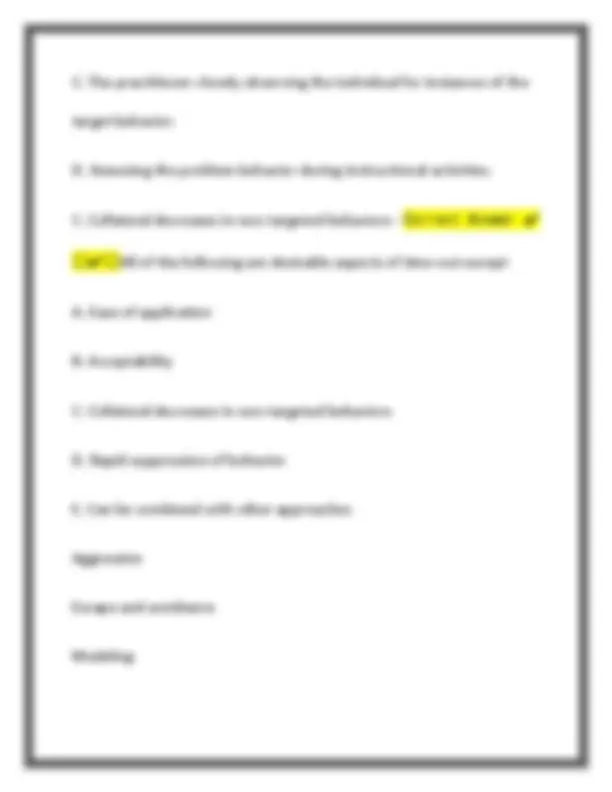
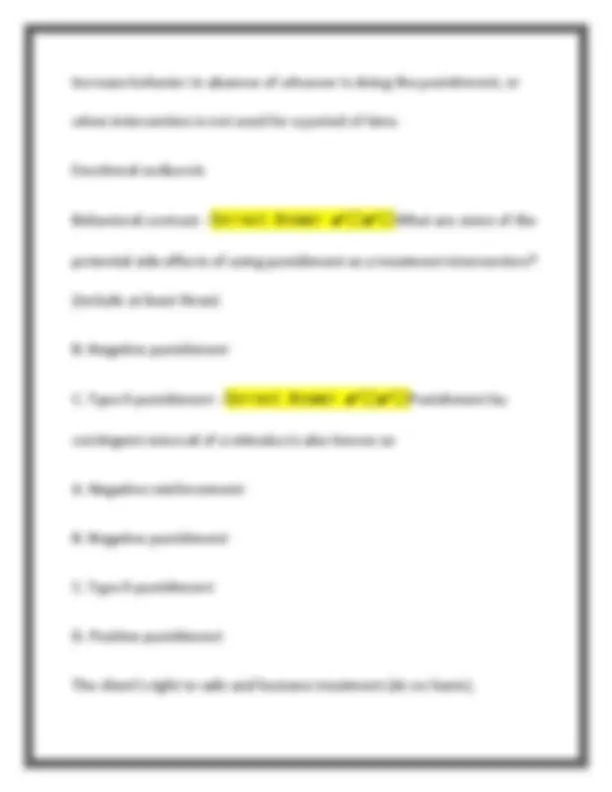
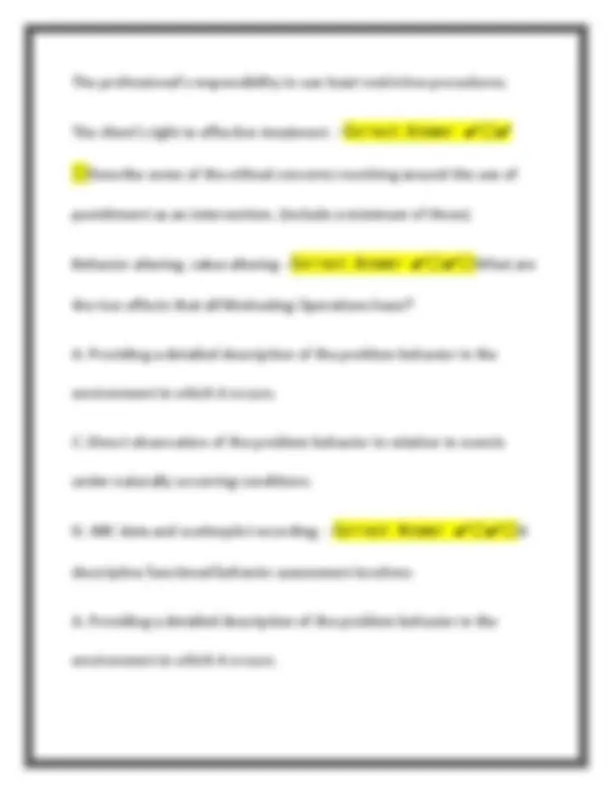
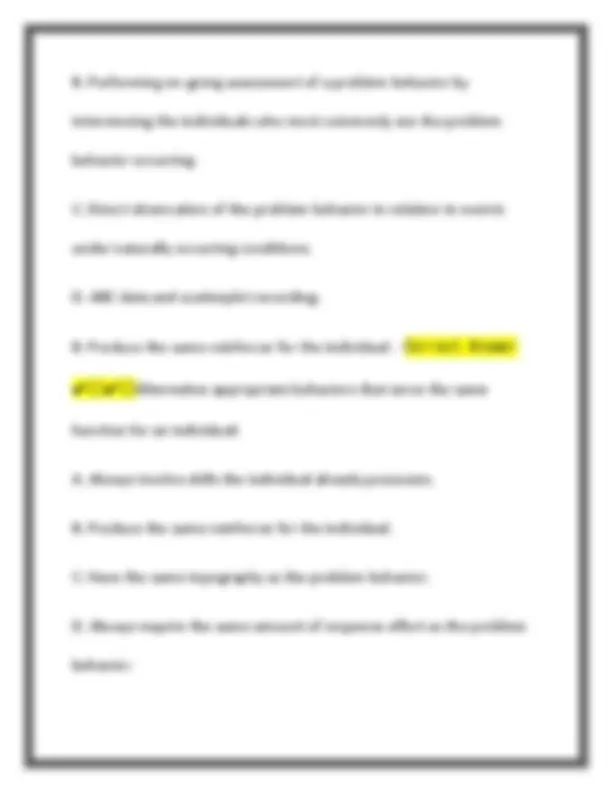
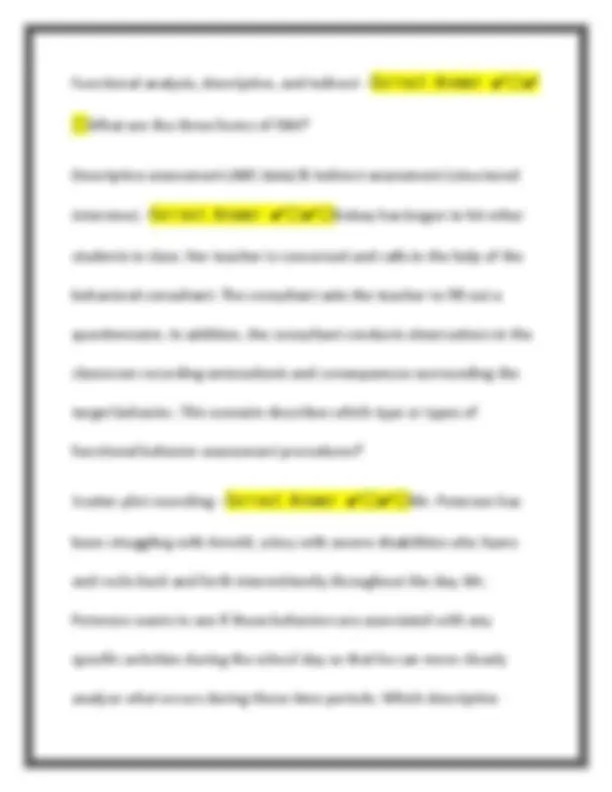
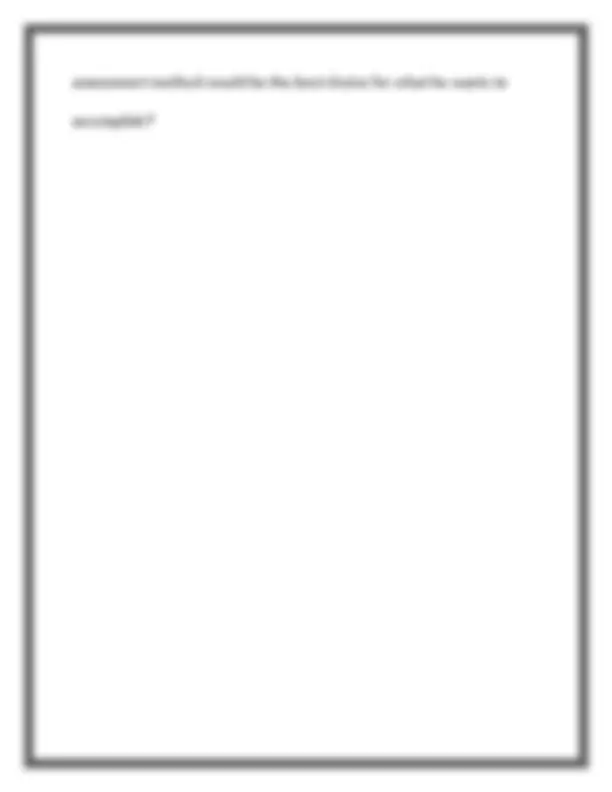


Study with the several resources on Docsity

Earn points by helping other students or get them with a premium plan


Prepare for your exams
Study with the several resources on Docsity

Earn points to download
Earn points by helping other students or get them with a premium plan
Community
Ask the community for help and clear up your study doubts
Discover the best universities in your country according to Docsity users
Free resources
Download our free guides on studying techniques, anxiety management strategies, and thesis advice from Docsity tutors
ABA 139 Exam Questions And Complete Solutions | Test Your Knowledge | A + Rated
Typology: Exams
1 / 61

This page cannot be seen from the preview
Don't miss anything!






















































Attention - Correct Answer ✔️ ✔️ A child often spits and yells when her one-on-one teaching assistant leaves her side to interact with another student. When this occurs, her teaching assistant returns to her side, and asks her to stop. The child rarely demonstrates these behaviors when her assistant works directly with her. What is the most likely function of this child's problem behavior? Escape/avoidance - Correct Answer ✔️ ✔️ Samuel hits his teacher when he prompts him to complete a toothbrushing task. Normally when this occurs, the teacher allows Samuel to leave the toothbrushing task and go to the computer to calm down. As long as he is playing on the computer, Samuel rarely spits on his teacher. What is the most likely function of Samuel's behavior?
Understanding why a behavior occurs will help determine how it can be changed for the better. By gaining a better understanding about what function a behavior serves, the most appropriate intervention can be used. It helps us avoid using default technology. Function informs intervention. - Correct Answer ✔️ ✔️ Why is it important to understand why behavior occurs before how it can be changed? Fixed ratio, variable ratio, fixed interval, and variable interval - Correct Answer ✔️ ✔️ What are the four basic schedules of intermittent reinforcement? A behavioral effect associated with abrupt increases in ratio requirements when moving from denser to thinner reinforcement schedules; common effects include avoidance, aggression, and unpredictable pauses or cessation in responding. - Correct Answer ✔️ ✔️ What is ratio strain? An analysis of the purposes (functions) of problem behavior, wherein antecedents and consequences representing those in the person's
C. They allow the practitioner to better control the individual exhibiting the problem behavior than in the naturally occurring routine. D. They represent all situations in the natural environment. Contingent attention Contingent escape Alone - Correct Answer ✔️ ✔️ In addition to a control condition, a functional analysis typically consists of what test conditions? High levels across all conditions High levels in alone condition - Correct Answer ✔️ ✔️ List two of the three patterns of functional analysis results that are indicative of an automatic reinforcement function. B. Correlations, causal relationships - Correct Answer ✔️ ✔️ While most assessment in the FBA process identify ________________, the functional analysis identifies ________________ between environmental events and problem behavior.
A. Reinforcers, motivating operations B. Correlations, causal relationships C. Causal relationships, correlations D. Punishers, reinforcers Changing designs (e.g.,pairwise or reversal) or using different therapists/rooms/colored t-shirts for each condition. - Correct Answer ✔️ ✔️ Describe one of the procedural or environmental modifications used to increase discrimination during a functional analysis. AB & ABC - Correct Answer ✔️ ✔️ What are the two "models" of functional analysis discussed in the introduction of the Hanley et al. article? Typical assessments are usually 10-15 minutes. Rates of behavior are observed under one or more test conditions, compared to a control condition. They are repeated until response differentiation is seen.
C. Run each condition multiple times with a session length of 5 min. D. Run each condition once with the session length of 20 min. and conduct a contingency reversal. Preference assessments can show the reinforcer preferred by an individual (positive social reinforcement, negative social reinforcement). That information can be applied to assessing function. If positive social reinforcement is preferred, it is possible that it will also reinforce problem behaviors. - Correct Answer ✔️ ✔️ How can a preference assessment be used to assess behavioral function? Spikes and values and behavior can be seen instead of just viewing averages. They're less likely to produce false-positive results. - Correct Answer ✔️ ✔️ What can be gained by conducting a within session analysis? A. Attention and toys versus alone with nothing B. Attention versus toys
C. Attention with task demands versus alone with nothing D. Attention with task demands versus alone with toys - Correct Answer ✔️ ✔️ What of the following were conditions used in the Berg et al. article? A. Attention and toys versus alone with nothing B. Attention versus toys C. Attention with task demands versus alone with nothing D. Attention with task demands versus alone with toys A descriptive assessment is data/narrative from direct observation of the target behavior. Indirect assessment includes surveys and interviews with caretakers which collect perception of the behavior instead of data. - Correct Answer ✔️ ✔️ How does a descriptive assessment differ from an indirect assessment? A. Repeatability
In at least some cases items that remain unidentified as reinforcers in the MS procedure do function effectively as reinforcers, and that the MSWO and PS procedures more readily identify those items as reinforcers. So I would be more likely to choose MSWO for its ability to identify reinforces better than MS, and is faster than PS. - Correct Answer ✔️ ✔️ Describe the primary procedural differences between an MSWO and MS preference assessment and why one would choose one assessment over the other. B. Computer time may be a reinforcer for this student. D. Computer time is a preferred stimulus. - Correct Answer ✔️ ✔️ Assume you give a student in your class a forced-choice preference assessment. On this preference assessment, computer time is ranked higher (it was selected the most frequently). What can you say about computer time, based on this information? A. Computer time is a reinforcer for this student.
B. Computer time may be a reinforcer for this student. C. Computer time is a punisher for this student. D. Computer time is a preferred stimulus. C. Progressive-ratio schedule assessment. - Correct Answer ✔️ ✔️ If one wants to determine the effectiveness of the stimulus as a reinforcer relative to another stimulus, which assessment method would be most appropriate? A. Concurrent schedule assessment. B. Multiple schedule assessment. C. Progressive-ratio schedule assessment. D. Paired stimulus assessment. B. Multiple schedule assessment. - Correct Answer ✔️ ✔️ If one compares the effects of response dependent delivery of a stimulus to a response independent schedule of delivery of a stimulus to analyze
How reinforcers maintain their strength in the face of demands, satiation etc. - Correct Answer ✔️ ✔️ Name two of the three things that stimulus preference assessment are used to determine. Play Attention Demand Alone - Correct Answer ✔️ ✔️ What are the four conditions usually assessed in a functional analysis as described in the Iwata et al., 1982 article? Spontaneous recovery, extinction burst, and aggression - Correct Answer ✔️ ✔️ ____________, _____________, and ____________ are commonly described as associated effects of extinction. The target behavior ceases to be reinforced. There is commonly a spike in frequency and/or magnitude of the behavior. the behavior then gradually decreases in frequency until it reaches pre-reinforcement
levels or ceases completely. - Correct Answer ✔️ ✔️ Define the process of extinction. B. Resistance to extinction - Correct Answer ✔️ ✔️ A schedule of intermittent reinforcement will increase the ______________? A. Resistance to reinforcement B. Resistance to extinction C. Establishing operations D. Motivating operations Reinforcement and extinction - Correct Answer ✔️ ✔️ All differential reinforcement procedures combine the use of what two principles of behavior? D. A specific behavior other than disruption. - Correct Answer ✔️ ✔️ Assume you're teaching a large group of students, and they are very disruptive during your class. For example, the students talk out of turn,
C. Confusing noncontingent reinforcement and extinction D. Withholding of reinforcers that maintain the behavior A. Momentary DRO requires that the individual to anything other than the target problem behavior at the end of the interval. Interval DRL requires that the individual do anything other than the target problem behavior for the entire interval. - Correct Answer ✔️ ✔️ What is the difference between momentary DRO and interval DRO? A. Momentary DRO requires that the individual do anything other than the target problem behavior at the end of the interval. Interval DRL requires that the individual do anything other than the target problem behavior for the entire interval. B. Momentary DRO requires that the individual do a response that is incompatible with the type of problem behavior. Interval DRO does not have this requirement.
C. Momentary DRO is usually conducted for shorter time intervals than interval DRO. D. Momentary DRO is usually more effective early on in intervention, whereas interval DRO is more effective later in intervention. B. DRI involves reinforcing a behavior that is incompatible with the problem behavior, whereas DRA involves reinforcing a behavior that may not be incompatible with the problem behavior. - Correct Answer ✔️ ✔️ What is the difference between DRI and DRA?
A. With DRA, the time interval is reset, whereas with DRI it is not. B. DRI involves reinforcing a behavior that is incompatible with the problem behavior, whereas DRA involves reinforcing a behavior that may not be incompatible with the problem behavior. C. DRA involves reinforcing anything other than the problem behavior, whereas DRI involves reinforcing any behavior that is incompatible with the problem behavior.
C. Contingency independent - Correct Answer ✔️ ✔️ Functions for antecedent stimuli are classified as: A. Contingency dependent B. Contingency codependent C. Contingency independent D. Contingency non-dependent C. Abolishing operation - Correct Answer ✔️ ✔️ Noncontingent reinforcement functions as a: A. Establishing operation B. Motivating operation C. Abolishing operation D. Premack principle An antecedent intervention in which 2 to 5 easy tasks with a known history of learner compliance are presented in quick succession
immediately before requesting the target task. - Correct Answer ✔️ ✔️ Define high-P sequence?
DRA - differential reinforcement of alternative behavior - Correct Answer ✔️ ✔️ Functional communication training is an application of what procedure? A. Dense schedules of reinforcement B. Decreased use of verbal prompts C. Behavior reduction procedures D. Schedule thinning - Correct Answer ✔️ ✔️ Effective use of functional communication training includes: A. Dense schedules of reinforcement B. Decreased use of verbal prompts C. Behavior reduction procedures D. Schedule thinning